![]()
![]()
![]()
Use LEFT and RIGHT arrow keys to navigate between flashcards;
Use UP and DOWN arrow keys to flip the card;
H to show hint;
A reads text to speech;
177 Cards in this Set
- Front
- Back
|
mammal phylogeny to infraclass
|
kingdom: Animalia, Phylum: Chordata, Class: Mammalia, Subclass: Prototheria Order: Monotrema, Subclass: Theria, Infraclass: Metatheria (Marsupials), Infraclass: Eutheria (Placentalia)
|
|
|
Subclass Prototheria
|
Order: Monotremata, platypus, echidnas, spiny anteaters, primitive traits (not well developed mammary glands, lay eggs, but well adapted sensory abilities)
|
|
|
Subclass Theria
|
typical mammals infraclass: Metatheria (marsupials) has been broke into 7 orders *be able to id as marsupials for practical* most marsupials in Australia and South America - have placentas but develop from different tissues than in Eutharia infraclass: Eutheria (placental mammals)
|
|
|
Metatheria (Marsupial) Characters
|
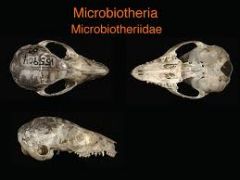
7 orders (opossums, rat opossums, Numbat, bandicoots, marsupial mole, koala, wombats, cuscuses, rat kangaroos, kangaroos, possums) braincase small, auditory bullae usually absent, large vacuities in palate, large jugal bone, primitive dental formula (5/4, 1/1, 3/3, 4/4 = 50) epipubic bones
|
|
|
Order Chiroptera characters
|
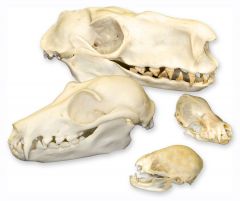
Oregon Chiroptera:
anterior end of skull broad and blunt, with distinct U-shaped notch, forearm, hand and fingers modified into membrane-covered wing, membrane between rear limbs incorporates all or most of tail, hind limbs rotated so knees bend backward, ears long with well-developed tragi |
|
|
Order Rodentia Characteristics
|
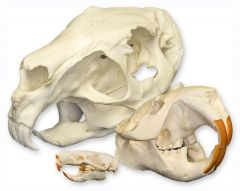
single pair of upper and lower incisors, diastema, reduced number of molariform teeth, typical dental formula , no species has more than 2 pairs of premolars or more than 22 teeth,
Oregon rodentia: upper incisors =1, lower incisors = 1, ears usually shorter than tail, 1/1, 0/0, 0/0, 3/3 (10-03/10-03)= 16 |
|
|
Order Lagomorpha Characteristics
|
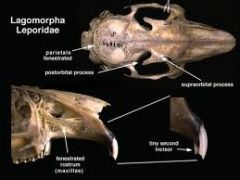
peg teeth, broad diastema, (20-32/10-23)
cheekteeth hypsodont with two transverse enamel ridges, rostral portion of maxilla is fenestrated, frontal bone has supraorbital process, ears longer than tail, haired soles of feet, 2/1, 0/0, 3/2, 2-3/3=26-28 sometimes extra M Oregon lagomorpha (pika, 4 rabbits, 3 hares): ears longer than tail, haired soles of feet |
|
|
2 families in Chiroptera
|
Vespertilionidae, Molossidae
|
|
|
2 families in Lagomorpha
|
Ochotonidae, Leporidae
|
|
|
9 families in Rodentia
|
Aplodontidae, Sciuridae, Geomyidae, Heteromyidae, Castoridae, Muridae (subfamilies: Sigmodontinae, Murinae, Arvicolinae), Dipodidae, Erethizontidae, Myocastoridae
|
|
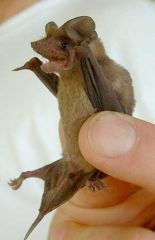
Tadarida brasiliensis (Brazilian free-tailed bat)
|

free tail, bifid lower incisors, (11-23/21-23)
one upper incisor, short ears, scruffy fur, 1/2, 1/1, 2/2, 3/3= 30/32 (7/8), sometimes extra i |
|
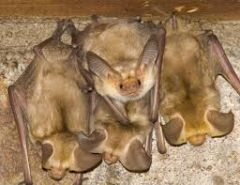
Antrozous pallidus (pallid bat)
|

long ears, sagittal crest, (11-22/21-23)
1 upper incisor, yellowish fur, 1/2, 1/1, 2/2, 2/3= 28 (6/8), tiny lower premolar |
|
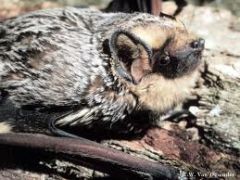
Lasiurus cinereus (hoary bat)
|

hairy patagial membrane, (11-13/31-23)
short ears, 1 upper incisor, yellowish to brown fur with frosty tips, 1/3, 1/1, 1/2, 3/3= 30/32 (6/9) (sometimes extra P) |
|
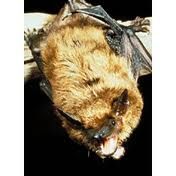
Eptesicus fuscus (big brown bat)
|

semi-prominent sagital peak, (21-12/31-23),
short ears, 2 upper incisors, fr>40mm, uniform brown fur with blackish basal root, blackish ears face and patagium, large skull, 2/3, 1/1, 1/2, 3/3 = 32 (7/9) |
|
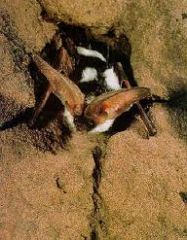
Euderma maculatum (spotted bat)
|
3 large dorsal spots on dark chocolate fur, (21-23/31-23)
long ears, 2 upper incisors, large skull, 2/3, 1/1, 2/2, 3/3=34 (8/9) |
|
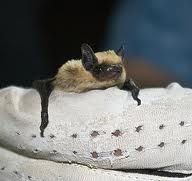
Pipistrellus hesperus (western pipistrelle)
|

short ears, light yellowish brown fur, (21-23/31-23)
basal 1/3-1/2 of hair shaft dark, 2 upper incisors, distal portion pale, 2/3, 1/1, 2/2, 3/3= 34 (8/9), (first premolar is miniscule) |
|
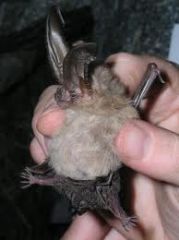
Corynorhinus townsendii (Townsend's big eared bat)
|

long ears, large skull, (21-23/31-33)
2 upper incisors, brown fur, high forehead, 2/3, 1/1, 2/3, 3/3 = 36 (8/10), tiny first premolar, |
|
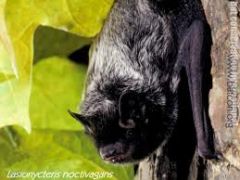
Lasionycteris noctivagans (silver-haired bat)
|

blackish, brown fur tipped with silvery white, (21-23/31-33)
2 upper incisors, proximal portion of patagial membrane hairy large skull, skull flat in profile, 2/3, 1/1, 2/3, 3/3= 36 (8/10), |
|
|
Myotis characteristics and 7 spp in OR
|
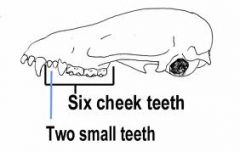
(21-33/31-33), small size, brown fur
2 upper incisors, small skull, 2/3, 1/1, 3/3, 3/3 = 38 (9/10), 1. M. californicus (California myotis), 2. M. ciliolabrum (western small-footed myotis), 3. M. evotis (long-eared myotis) 4. M. lucifugus (little brown bat) 5. M. thysanodes (fringed myotis) 6. M. volans (long-legged myotis) 7. M. yumanensis (Yuma myotis) |
|
|
14 species in family vespertilionidae in Oregon
name the 7 non-myotis spp |
8. Lasiurus cinereus (hoary bat) 9. Lasionycteris noctivagans (silver-haired bat) 10. Pipistrellus hesperus (western pipistrelle 11. Eptesicus fuscus (big brown bat) 12. Euderma maculatum (spotted bat) 13. Corynorhinus townsendii (Townsend’s big-eared bat) 14. Antrozous pallidus (pallid bat)
|
|
|
1 species in family Molossidae in Oregon
|
Tadarida brasiliensis (Brazilian free-tailed bat)
|
|
|
1 species in family Ochotonidae in Oregon
|
Ochotona princeps (American pika)
|
|
|
6 species in family Leporidae in Oregon
|
1. Sylvilagus floridanus (eastern cottontail) 2. Sylvilagus bachmani (brush rabbit) 3. Sylvilagus nuttallii (mountain cottontail) 4. Lepus americanus (snowshoe hare) 5. Lepus californicus (black-tailed jackrabbit) 6. Lepus townsendii (white-tailed jackrabbit)
|
|
|
1 species in family Aplodontidae in Oregon
|
Aplodontia rufa (mountain beaver)
|
|
|
17 species in family Sciuridae in Oregon
4 Tamias 1 Marmota 1 Ammospermophilus 5 Spermophilus 3 Sciurus 2 Tamiasciurus 1 Glaucomys |
1. Tamias amoenus (yellow-pine chipmunk) 2. T. minimus (least chipmunk) 4. T. siskiyou (Siskiyou chipmunk) 4. T. townsendii (Townsend’s chipmunk) 5. Marmota flaviventris (yellow-bellied marmot) 6. Ammospermophilus leucurus (white-tailed antelope squirrel) 7. Spermophilus beecheyi (California ground squirrel) (Citellus) 8. S. beldingi (Belding’s ground squirrel) (Citellus) 19. S. canus (townsendii) Merriam’s (Townsend’s) ground squirrel (Citellus) 10. S. columbianus (Columbian ground squirrel) 11. S. lateralis (golden-mantled ground squirrel) 12. Sciurus carolinensis (eastern gray squirrel-introduced) 13. S. griseus (western gray squirrel) 14. S. niger (eastern fox squirrel-introduced) 15. Tamiasciurus douglasii (Douglas’ squirrel) 16. T. hudsonicus (red squirrel) 17. Glaucomys sabrinus (northern flying squirrel)
|
|
|
5 species in Geomyidae in Oregon
|
1. Thomomys bottae (Botta’s pocket gopher) 2. T. bulbivorus (camas pocket gopher) 3. T. mazama (western pocket gopher) 4. T. talpoides (northern pocket gopher) 5. T. townsendii (Townsend’s pocket gopher)
|
|
|
6 species in family Heteromyidae in Oregon
|
1. Perognathus longimembris (little pocket mouse) 2. P. parvus (Great Basin pocket mouse) 3. Microdipodops megacephalus (dark kangaroo mouse) 4. Dipodomys californicus (California kangaroo rat) 5. D. microps (chisel-toothed kangaroo rat) 6. D. ordii (Ord’s kangaroo rat)
|
|
|
1 species in family Castoridae in Oregon
|
Castor canadensis (American beaver)
|
|
|
3 sub-families in family Muridae in Oregon
|
Sigmodontinae, Murinae, Arvicolinae
|
|
|
8 species in sub-family Sigmodontinae in Oregon
|
1. Reithrodontomys megalotis (western harvest mouse) 2. Peromyscus crinitus (canyon mouse) 3. P. maniculatus (deer mouse) 4. P. truei (Pinon mouse) 5. Onychomys leucogaster (northern grasshopper mouse) 6. Neotoma cinerea (bushy-tailed woodrat) 7. N. fuscipes (dusky-footed woodrat) 8. N. lepida (desert woodrat)
|
|
|
2 species in subfamily Murinae in Oregon
|
1. Rattus norvegicus (Norway rat-introduced), 2. Mus musculus (house mouse- introduced)
|
|
|
11 species in sub-family Arvicolinae in Oregon
Myodes Phenacomys Microtus Lemmiscus Ondatra |
1. Myodes californicus (western red-backed vole) 2. Myodes gapperi (southern red-backed vole) 3. Phenacomys intermedius (heather vole) 4. Microtus californicus (California vole) 5. Microtus longicaudus (long-tailed vole) 6. Microtus montanus (montane vole) 7. Microtus oregoni (creeping vole) 8. Microtus richardsoni 9. Microtus townsendii (Townsend’s vole) 10. Lemmiscus curtatus (sagebrush vole) 11. Ondatra zibethicus (common muskrat)
|
|
|
2 species in family Dipodidae in Oregon
|
Zapus princeps (western jumping mouse) Zapus trinotatus (Pacific jumping mouse)
|
|
|
1 species in family Erethizontidae in Oregon
Erethizon dorsatum (common porcupine) |
large, short-legged rodent w/ 30,000 quills, molars converge anteriorly, strongly pigmented incisors, infraorbital foramen oval
|
|
|
1 species in family Myocastoridae in Oregon
Myocastor coypus (nutria-introduced) |
large rat-like semiaquatic rodent, round nearly hairless tail, hind toes webbed, eyes ears and nose high on head, infraorbital foramen round
|
|
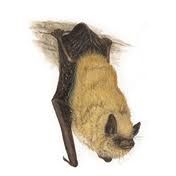
Myotis californicus (California myotis)
|
keel, dish face, forearm >30.5mm
face and ears brown, dorsal pelage not glossy or burnished, foot <8.5mm, similar sp. M. ciliolabrum, |
|
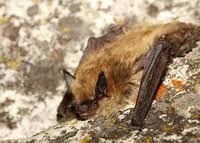
Myotis ciliolabrum (western small-footed myotis)
|
keel, flat face
face and ears black, dorsal pelage rich yellowish-brown and glossy or burnished, ventral pelage is buff, exerted tail, 3rd metacarpal (<30.5mm) shorter than forearm, sim sp. M. californicus, |
|
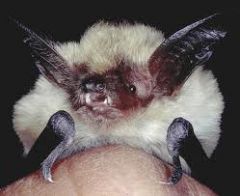
Myotis evotis (long-eared myotis)
|

no keel, flat face, long ears
forearm <40mm, tragus >6mm pointed and straight, ears >2mm longer than nose, dorsal pelage glossy pale brown (eastern Oregon) to golden brown (western Oregon), venter is whitish to buff, bases of hairs black, ears, wings and uropatagium are blackish, skull narrow with oval braincase without distinct step, closely related to M. thysanodes |
|
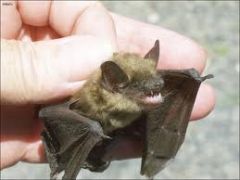
Myotis lucifugus (little brown myotis)
|

no keel, flat face, short ears
fr <40mm, ears <2mm longer than nose, tragus pointed straight & >6mm, dorsal pelage usually glossy golden brown to dark brown, venter is whitish to buff hairs dark at base, skull us. >14mm |
|
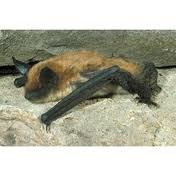
Myotis thysanodes (fringed myotis)
|

fringe, sagital crest, no keel, long ears
fr >40mm, simplified molars, pelage yellowish brown to almost brassy, bases of hairs nearly black, venter considerably lighter in color, closely related to M. evotis |
|
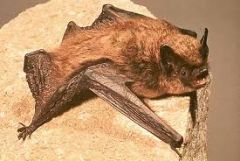
Myotis volans (long-legged myotis)
|

keel, dish face, fr >35mm
short, round ears, foot >8.5mm, dorsal pelage ocherous buff east of Cascades and dark smoky-brown west of the Cascades, venter is lighter hue, ears and flight membranes blackish, skull small with short rostrum and globose braincase |
|
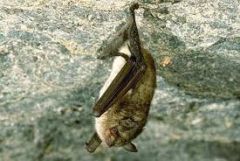
Myotis yumanensis (Yuma myotis)
|
no keel, dishface
forearm<36mm, venter is whitish (esp. at throat) to buffy or tan, skull us. >14mm, dorsal pelage ranges from olive tan to dark brown, similar to M. lucifugus except dorsal pelage is short and dull |
|
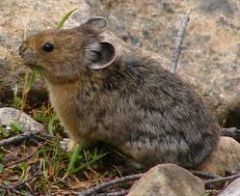
Ochotona princeps (American pika)
|

no tail, fenestrated rostrum transparent membrane not holes
rat-sized, ear rounded & edged with white, length of front and rear legs subequal, hind foot <40mm long, toe pad naked, pelage brownish black on dorsum blending to ash gray on sides and to buffy or whitish border, frontal bones without supraorbital process, |
|
|
Family Leporidae characteristics
|
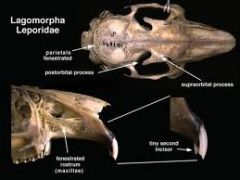
Ear at least twice as long as wide, edge of ear at least as dark as remainder of ear, 28 teeth, visible external tail
|
|

Sylvilagus bachmani (brush rabbit)
|
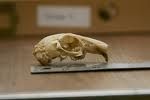
dorsal pelage uniformly dark brown, hairs on belly lead colored with pale tips, ventral surface of tail not cottony white
tip of ear not noticeably darker than other portions nor bounded with white, hind foot <=85mm, |
|
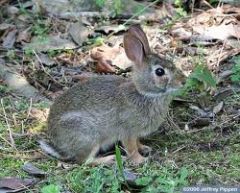
Sylvilagus floridanus (eastern cottontail)
|

nape reddish
pelage on rump brownish, legs reddish to yellowish, top of tail brownish |
|

Sylvilagus nuttallii (mountain cottontail)
|

pelage on rump grayish, white tail
ruddy legs, relatively broad, rounded ears |
|

Lepus americanus (snowshoe hare)
|

reddish brownish in summer, top of tail sim. color to body
hind foot>105mm, ear <=80mm, anterior projection of supraorbital process lacking, occipitonasal length <75mm, commonly white in winter ex. in Coast Range |
|
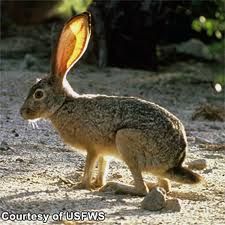
Lepus californicus (black-tailed jackrabbit)
|

top of tail and tip of ears black
hind feet >105mm, ears >80mm, tail black on dorsal surface, buffy or brownish on ventral surface, rostrum narrow and tapering |
|
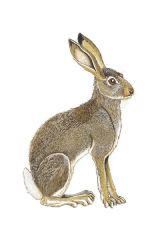
Lepus townsendii (white-tailed jackrabbit)
|

tail white except occasionally with dusky dorsal stripe
hind feet >105 mm, ears >80 mm summer and winter pelages different, in summer hairs are light gray at base followed by brown, buff and narrow tip of black, winter hairs are white at base followed by band of gray white and black tip, |
|
|
Aplodontidae characteristics
Aplodontia rufa (mountain beaver) |
tail extremely short, pelage uniformly dark brown with white spot below ear, upper molariform teeth with labial spinelike projections, lower molariform teeth with lingual spinelike projections, auditory bulla flask shaped
|
|
|
Sciuridae characteristics
|
tail visible and bushy, often flattened dorsoventrally, prominent postorbital processes,
4 lower molariform teeth, small infraorbital foramen on or close to zygomatic plate, |
|
|
Geomyidae characteristics
|
two external fur-lined cheek pouches, tail shorter than head & body with little to no hair, zygomatic arches nearly parallel, infraorbital foramen small not connected and anterior to zygomatic plate
robust, small eyes and ears, short legs, five toes on forefeet terminating with powerful claw, legs about equal length, |
|
|
Heteromyidae characteristics
|
tail longer than head and body and hairy, external fur-lined cheek pouches, infraorbital foramen small connected (nose ring) and anterior to zygomatic plate,
hind legs longer than front, large auditory bullae, upper incisors grooved on front |
|
|
Castoridae characteristics
Castor canadensis (American beaver) |
L, tail spatulate scaly and nearly hairless, hind feet webbed with web extending beyond proximal edge of toenail, large skull >75mm, minute infraorbital foramen, transverse enamel loops in molariforms, total teeth=20
|
|
|
Muridae characteristics
|
tail <150% of length of head and body, hind feet not greatly modified for jumping, 16 teeth, 3 upper molariform teeth, small slit-like infraorbital foramen on or close to zygomatic plate
|
|
|
Dipodidae characteristics
|
tail ~=150% of length of head and body, 3 upper molariform teeth plus peg-like tooth
hind feet modified for jumping, 18 teeth, small infraorbital foramen on or close to zygomatic plate |
|
|
Erethizontidae characteristics
|
four digits on front feet, five on hind feet, feet not webbed, large infraorbital foramen, incisive foramen does not extend past premaxillary
|
|
|
Myocastoridae characteristics
|
long round sparsely haired scaly tail, hind feet webbed, upper molariforms converge greatly anteriorly
small eyes and small nearly hairless ears, dark orange incisors, pentadactyl, large infraorbital foramen, incisive foramen extends past premaxillary |
|
|
3 sub-families in Muridae
|
Sigmodontinae, Murinae, Arvicolinae
|
|
|
How to distinguish Sylvilagus & Lepus
|
Sylvilagus has interparietal suture line and Lepus does not
|
|
|
Tamias amoenus (yellow-pine chipmunk)
|
L, rusty sides, small
|
|
|
Tamias minimus (least chipmunk)
|
gray sides, small
|
|
|
Tamias siskiyou (Siskiyou chipmunk)
|
L, large, inner dorsal stripes gray, outer pair of light stripes brighter than inner pair, shoulders and rump brownish
|
|
|
Tamias characteristics
|
four dark and five light stripes starting on face, groove on front of incisors, incisors orange
|
|
|
Tamias townsendii (Townsend's chipmunk)
|
large, 3-5 dorsal stripes black, dorsal light stripes cinnamon buff to tawny with outermost ~ same color as innermost
|
|
|
Marmota flaviventris (yellow-bellied marmot)
|
large, yellow belly, dark bar across nose, kinda like aplodontia with furry tail
|
|
|
Ammospermophilus leucurus (white-tailed antelope squirrel)
|
looks like a gray chipmunk without stripes on face, light stripes on sides, infraorbital foramen narrow oval with spinelike projection
|
|
|
Spermophilus beecheyi (California Ground Squirrel) (Citellus)
|
L, black nape, tail >128mm
|
|
|
Tamias characteristics
|
stripes on face, infraorbital foramen visible from ventral surface
incisors with grooves on front, (4spp) |
|
|
Spermophilus characteristics
|
no stripes on face, twisted dorsoventrally flattened zygomata that converge anteriorly, (5spp)
|
|
|
Sciurus characteristics
|
zygomata untwisted, flattened laterally and nearly parallel, (3spp)
|
|
|
Spermophilus beldingi (Belding's ground squirrel) (Citellus)
|
med size, uniform color top to bottom, reddish-brownish, distal tail hairs with 3 color bands
|
|
|
Spermophilus canus (Citellus townsendii) (Merriam's (Townsend's) ground squirrel)
|
whitish stripes on sides
|
|
|
Spermophilus columbianus (Columbian ground squirrel)
|
rusty nose legs and tail, buffy gray w/ small whitish spots, hind foot<39mm
|
|
|
Spermophilus lateralis (golden-mantled ground squirrel)
|
L, fewer stripes than chipmunks and none on face, light stripe bordered with black, head and shoulders deep golden yellow
|
|
|
Sciurus carolinensis (eastern gray squirrel)
|
scruffier and rustier tail than S. griseus, hind foot <70mm
introduced-Portland area only |
|
|
Sciurus griseus (western gray squirrel)
|
L, thick bushy silvery gray tail, hind foot >70mm
|
|
|
Sciurus niger (eastern fox squirrel)
|
rusty-orange red, thin tail, skull and bones reddish, introduced
|
|
|
Tamiasciurus douglasii (Douglas' squirrel)
|
L, white sides and tip of tail, dusky-to grayish olive, belly light yellowish to orangish, yellowish or white-tipped hairs on tail
|
|
|
Tamiasciurus hudsonicus (red squirrel)
|
reddish gray to reddish olive, white belly, black-tipped tail hairs
|
|
|
Glaucomys sabrinus (northern flying squirrel)
|
L, membrane bet. fore-and hind limbs
|
|
|
Thomomys bottae (Botta's pocket gopher)
|
L, rusty orangish color, sphenoidal fissure, hind foot <33mm
|
|
|
standard 4 measurements on tags
|
total length, tail, hind foot, ear
|
|
|
Thomomys bulbivorus (Camas pocket gopher)
|
white patch on throat, sphenoidal fissure, dark sooty brown
|
|
|
Thomomys mazama (western pocket gopher)
|
L, higher elevation, long ears >6.9mm, black black with reddish stripe or reddish brown
|
|
|
Thomomys talpoides (northern pocket gopher)
|
short ears <6.9mm, yellowish-gray to yellowish-brown
|
|
|
Thomomys townsendii (Townsend's pocket gopher)
|
grayish to grayish-brown, sphenoidal fissure
|
|
|
large footed heteromyids (>=34mm)
|
Dipodomys californicus, D. microps, D. ordii
|
|
|
small footed heteromyids (<27mm)
|
Perognathus longimembris, P. parvus, Microdipodops megacephalus,
|
|
|
Perognathus longimembris (little pocket mouse)
|
tiny skull, hind foot <20mm, pinkish buff to ocherous buff with blackish guard hairs, bicolored tail
|
|
|
Perognathus parvus (Great Basin pocket mouse)
|
hind foot > 20 mm, lateral line separating back and belly
|
|
|
Microdipodops megacephalus (dark kangaroo mouse)
|
large auditory bullae, hind feet <27mm
tail light proximally and darkening distally, gray to brown, tail thick in middle and tapering at both ends, |
|
|
Dipodomys microps (chisel-toothed kangaroo rat)
|
dark ventral tail stripe uniform width
foot >34mm, |
|
|
Dipodomys ordii (Ord's kangaroo rat)
|
dark ventral tail stripe tapers to point, foot >34mm, common at Hart Mtn
|
|
|
Dipodomys californicus (California kangaroo rat)
|
L, darkest,
hind foot >34mm, 4 toes on hind foot, white tip on tail |
|
|
Reithrodontomys megalotis (western harvest mouse)
|
L, 3 molars, grooved incisors
|
|
|
subfamily Sigmodontinae
|
ears long, membranous and not concealed by hairs in front of them, braincase tapers gradually, keyhole shaped infraorbital foramen
|
|
|
large footed sigmodontinae (>28mm)
|
Neotoma sp.
|
|
|
small footed sigmodontinae (<28mm)
|
R. megalotis, O. leucogaster, Peromyscus sp.
|
|
|
Peromyscus crinitus (canyon mouse)
|
silky pelage, tail >55% total length, 4 mammae
|
|
|
Peromyscus maniculatus (deer mouse)
|
L, coarser pelage, ear <22mm,
|
|
|
Peromyscus truei (Pinon mouse)
|
L, ear >22mm (almost always longer than hind foot)
|
|
|
Onychomys leucogaster (northern grasshopper mouse)
|
short tail <60% head and body,
|
|
|
Neotoma cinerea (bushy-tailed woodrat)
|
L, bushy tail
|
|
|
Neotoma fuscipes (dusky-footed woodrat)
|
L, belly hairs white to base, tail >150mm
|
|
|
Neotoma lepida (desert woodrat)
|
belly hairs gray at base w/ white tip, eastern OR
|
|
|
subfamily Murinae (old world rats and mice) characteristics
|
tail scaly, relative small size
|
|
|
Rattus norvegicus (Norway rat)
|
L, introduced, tail slightly shorter than body
|
|
|
Mus musculus (house mouse)
|
introduced, L, length of head and body <100mm, upper incisors notched on posterior surface, more uniform color
|
|
|
Zapus princeps (western jumping mouse)
|
L and eastern OR, lemon yellow color
|
|
|
Zapus trinotatus (Pacific jumping mouse)
|
coastal, more orange
|
|
|
aplodontidae skull
|
spine like projections on teeth (labial on upper & lingual on lower), flask shaped auditory bullae
Aplodontia rufa mountain beaver |
|
|
erethizontidae skull
|
large infraorbital foramen, incisive foramen does not extend past premaxillary
Erethizon dorsatum common porcupine |
|
|
myocastoridae skull
|
large infraorbital foramen, incisive foramen extends past premaxillary, upper molariforms converge greatly anteriorly
Myocastor coypus nutria |
|
|
castoridae skull
|
minute infraorbital, large skull (>75mm), transverse enamel loops in molariforms, 20 teeth
|
|
|
heteromyidae skull
|
small infraorbital foramen, infraorbital foramen anterior to zygomatic plate, infraorbital foramen connected
pocket mice (Perognathus & Microdipodops) and roo rats (Dipodomys) |
|
|
geomyidae skull
|
small infraorbital foramen, infraorbital foramen on or close to zygomatic plate, infraorbital foramen not connected
pocket gophers (Thomomys) |
|
|
sciuridae skull
|
small infraorbital foramen, infraorbital foramen on or close to zygomatic plate, prominent postorbital processes
chipmunks (Tamias), squirrels (Ammospermophilus, Sciurus, & Tamiasciurus), ground squirrels (Spermophilus), marmots (Marmota) and flying squirrels (Glaucomys) |
|
|
dipodidae skull
|
small infraorbital foramen, infraorbital foramen on or close to zygomatic plate, 3 upper molariform teeth plus peg-like cheek teeth
jumping mice (Zapus) |
|
|
muridae skull
|
small infraorbital foramen, infraorbital foramen on or close to zygomatic plate, 3 upper molariform teeth
mice, voles, rats, woodrats, muskrats (Reithrodontomys, Peromyscus, Onychomys, Neotoma, Rattus, Mus, Myodes, Phenacomys, Microtus, Lemmiscus, Ondatra) |
|
|
large rodent skulls
|
aplodontia, erethizon, myocastor, castor, marmota, ondatra
|
|
|
marmota skull (sciuridae)
|
minute infraorbital foramen, medium sized skull (<75mm), no transverse enamel loops in molariforms, 22 total teeth, incisors with many grooves
|
|
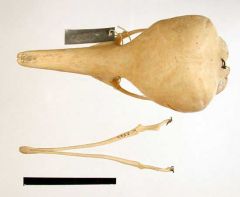
order monotremata characters
|

ECHIDNAS, DUCK-BILLED PLATYPUS:retain various reptilian characters such as: cloaca, young hatch from rubbery eggs, pelvic girdle similar to primitive therapsid reptiles, have mammary glands but not teats, skull morphology: (appear bird like) no teeth, elongated rostrum, high domed cranium, cochlea not coiled
|
|
|
Order Pilosa characters
|
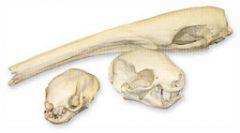
THREE-TOED TREE SLOTHS: forelimbs are longer than hindlimbs; incomplete zygomatic arch; large jugal forks; peg-like cheek teeth reduced to 5/4-5; 8-9 cervical vertebrae; tympanic bullae are present, TWO-TOED SLOTHS: tail is small/absent; true tympanic bullae absent; incomplete zygomatic arch; large forked jugal; incisors and canines absent, but anterior cheek teeth are enlarged, triangular in cross- section, and canine-like – they are separated from the remaining teeth by a diastema; 5-8 cervical vertebrae; skull longer than in bradypodids, SILKY ANTEATERS: prehensile tail; smallest anteater; dense golden fur; relatively short snout; incomplete zygomatic arch (jugal absent), GIANT ANTEATERS: edentate; elongated, downward curved skull; incomplete zygomatic arch (jugal small or absent); elongated dextrous tongue; forelimbs have 5 digits with claws – 3rd claw is typically largest; long palate
|
|
|
Order Cingulata characters
|

Armadillos: jointed, bony armor scutes made of dermal bone; keratinized plates cover the dermal bone; homodont (peg-like) dentition varies widely in number; fused tibia/fibula; large claws for digging; complete zygomatic arch (contrasts with sloths and anteaters)
|
|
|
Insectivore characters (polyphyletic generalization-not current phylogeny)
|
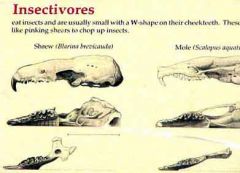
diverse group of 6 orders (shrews, moles, hedgehogs, tenrecs, solenodons, colugos)
small to medium-sized, pentadactyl, long somewhat pointed snouts, pinnae (external ears) and eyes small or absent, small braincase, ring-shaped tympanic bone instead of auditory bullae, jugal bone reduced or absent, reduced pubis symphysis, molars v- or w- shaped, dental formula in many spp (3/3, 1/1, 4/4, 3/3=44) orders in Oregon: canines smaller than incisors, zygomatic arch weak or absent, eyes minute or lacking external openings |
|
|
order Primates characters
|
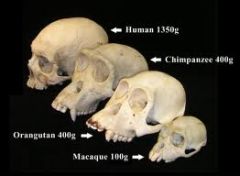
bony postorbital bar with eyes gen. directed forward, snout reduced, enlarged braincase, petrosal-covered auditory bulla, cheek teeth bunodont and brachyodont with sides of upper molars filled out
PRIMITIVE PRIMATES 2143 x2= 40 PROSIMIANS 2133 x2= 36 NEW WORLD MONKEYS 2133 x2= 36 MARMOSETS 2132 x2= 32 OLD WORLD MONKEYS 2123 x2= 32 APES 2123 x2= 32 HOMO SAPIENS 2123 x2= 32 |
|
|
Order Carnivora characteristics
|
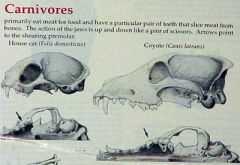
specializationof 4th upper premolar and first lower molar as shearing teeth, well developed, elongated canine teeth, heavy skulls with strong facial musculature, deep, sharply defined, C-shaped mandibular fossa
Oregon carnivora: canines larger than incisors, zygomatic arch strongly developed, eyes large |
|
|
Order Cetacea Characteristics
|
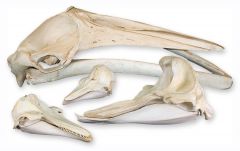
baleen or homodont, simple and peglike teeth, highly modified, telescoped skulls with posterior bones compressed and overlapping, elongated rostral portion, external nares on top of skull, asymmetrical skull structure esp around internal nares
Oregon Cetacea: Tail broadened horizontally into flukes, forearms modified as flippers but hind limbs absent, hair almost entirely absent, eyelids and external ear absent, nostrils towards the top of the head, teeth absent or homodont dentition |
|
|
Order Sirenia Characteristics
|
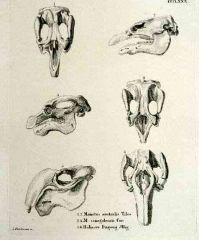
nostrils on top of rostrum, rostrum and lower jaw deflected downward, dense and massive skeletal bones
|
|
|
Order Proboscidea Characteristics
|
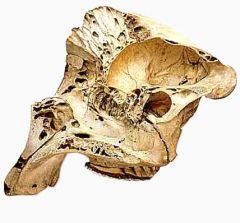
very large head, thick skull bones with series of sinuses, dental formula (1/0, 0/0, 3/3, 3/3 = 26, highly specialized teeth, upper incisor forms tusk, cheekteeth are large and hypsodont with transverse laminae, posterior cheekteeth larger than anterior, short mandible
|
|
|
Order Perissodactyla characteristics
|
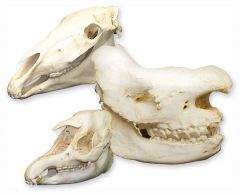
skull elongated by lengthening of rostrum, cheekteeth are hypsodont and us. lophodont, 3 upper incisors retained in equids and tapirids, reduced or absent in rhinos
|
|

Order Hyracoidea Characteristics
|

dental formula (1/2, 0/0, 4/4, 3/3) = 34, usually diastema between incisors and cheekteeth, upper incisors long Pointed, and triangular in cross section with gap between them, evergrowing with enamel only on front to keep sharp
|
|
|
Order Tubulidentata Characteristics
|
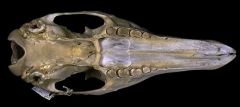
lots of turbinate bones in nasal passages, small eyes, elongated skull, small tubular mouth, no incisors or canines in adults, 20-22 cheekteeth
|
|
|
Order Artiodactyla Characteristics
|

Dentition varies-cheekteeth range from bunodont and brachyodont to selenodont and hypsodont, # varies, although in most upper incisors and canines are reduced or absent, some canines develop into tusks
Oregon Artiodactyla: feet with hooves, upper incisors absent, ruminant, at least males equipped with horns or antlers |
|
|
Order Pholidota Characteristics
|
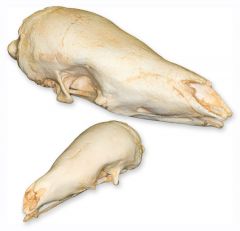
edentate, long tapered skull with straight slender mandible and incomplete zygomatic arches
|
|
|
Order Macroscelidea Characteristics
|
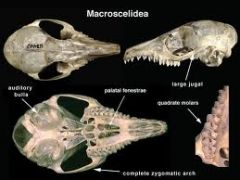
long, flexible snout, large eyes and ears, long soft pelage, long hind legs, forelimbs are pentadactyl, hind limbs have 4 or 5 toes, skull has complete zygomatic arch and auditory bullae, palate has series of large openings
|
|
|
bat skulls with 1 upper incisor
|
Tadarida, Antrozous, Lasiurus
|
|
|
Tadarida skull
|
bifid lower incisor
|
|
|
Antrozous skull
|
trifid lower incisor, sagittal crest
|
|
|
Lasiurus skull
|
trifid lower incisor, no sagittal crest
|
|
|
bat skulls with 2 upper incisors
|
Eptesicus, Euderma, Pipistrellus, Corynorhinus, Lasionycteris, Myotis
|
|
|
bat skulls with uppers 21-13
|
Eptesicus
|
|
|
bat skull with uppers 21-33
|
Myotis
|
|
|
bat skull with uppers 21-23
|
Corynorhinus, Euderma, Lasionycteris, Pipistrellus
|
|
|
Corynorhinus skull
|
forehead domed
|
|
|
Lasionycteris skull
|
forehead flat
|
|
|
Pipistrellus skull
|
small skull
|
|
|
Tamias skull
|
infraorbital foramen visible from ventral surface
|
|
|
Sciurus skull
|
zygomata untwisted, flattened laterally and nearly parallel
|
|
|
spermophilus skull
|
zygomata twisted dorsoventrally and converging anteriorly
|
|
|
Thomomys skull
|
heavy, flattened dorsoventrally, nearly parallel zygomata, infraorbital not connected small and anterior to zygomatic plate
|
|
|
Dipodomys skull
|
connected infraorbital foramen, triangular, large auditory bullae, large size,
|
|
|
Microdipodops skull
|
connected infraorbital foramen, triangular, large auditory bullae, small and thin
|
|
|
murinae skulls
|
occlusal surfaces of upper molars tuberculate with tubercles arranged serially in three longitudinal rows
|
|
|
lemmiscus skull
|
auditory bullae extend beyond occiput when viewed dorsally
|
|
|
peromyscus skull
|
condyloid process longer (middle lower jaw process)
|
|
|
onychomys skull
|
coracoid process longer (upper lower jaw process)
|
|
|
Reithrodontomys skull
|
front upper incisors grooved
|
|
|
perognathus skulls
|
inflated auditory bullae, connected infraorbital foramen, not as pronouncedly triangular as dipodomys or microdipodops
|
|
|
ammospermophilus skull
|
zygomata twist dorsoventrally and converge like spermophilus, infraorbital foramen has spinelike projection directly ventral to the opening
|
|
|
tamiasciurus skull
|
zygomata untwisted, compressed laterally and parallel like sciurus but maxilla not visible from above
|
|
|
Glaucomys skull
|
zygomata untwisted but not as parallel as other arboreal squirrels or as convergent as ground-dwelling squirrels
|
|
|
Arvicolinae characters
|
ears furred and almost hidden, small beady eyes, shelflike protrusion of squamosal causing braincase to taper abruptly, tails <65% head and body (except Ondatra)
|
|
|
Myodes californicus
|
western red-backed vole
|
|
|
Myodes gapperi
|
southern red-backed vole
|
|
|
Phenacomys intermedius
|
heather vole
|
|
|
Microtus californicus
|
california vole
|
|
|
Microtus longicaudus
|
long-tailed vole
|
|
|
Microtus montanus
|
montane vole
|
|
|
Microtus oregoni
|
creeping vole
|
|
|
Microtus richardsoni
|
water vole
|
|
|
Microtus townsendii
|
Townsend's vole
|
|
|
Lemmiscus curtatus
|
sagebrush vole
|
|
|
Ondatra zibethicus
|
common muskrat
|
|
|
Ondatra zibethicus skull
|
occipital crest
|

